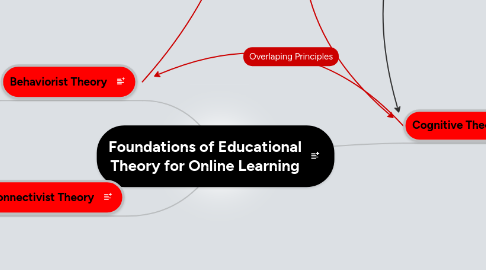
1. Behaviorist Theory
1.1. When a learner understands the material or a concept, there is observable behavior from the environment in which the learning takes place and not in the mind of the learner. EXTERNAL PROCESS
1.1.1. Thorndike, Pavlov, and Skinner
2. Connectivist Theory
2.1. The learning is not controlled by the learner because of the changes in their environment. For the learner to adapt, he must unlearn past material and relearn based off the change in the environment. EX: adding wireless capabilities to a machine that differs now in procedure.LEARNING IN CONNECTIVE NETWORK.
2.1.1. Siemes, Ally, Mukhopadhyay, Parhar, Schmidt, Werner,
3. Cognitive Theory
3.1. Learning deals with memory, motivation and thinking and reflections. The amount learner is based off the capacity, the effort, and the depth of learner's mind. INTERNAL PROCESS
3.1.1. Craik, Lockhart, Tulving, Ausubel
3.2. Cognitive Styles
3.2.1. learner’s preferred way of processing information. ( thinking, problem solving, remembering)
3.2.1.1. Witkin, Moore, Goodenough, Cox
3.3. Learning Styles
3.3.1. how a learner understands and interacts to the learning environment, this is what makes each individual different with how they learn.
3.3.1.1. Cassidy
3.3.2. The Kolb Learning Style Inventory (LSI) looks at how learners perceive and process information
3.3.2.1. Kolb
3.3.3. Myers-Briggs Type Indicator- sensing versus intuition, thinking versus feeling, and judging versus perception
3.3.3.1. Myers
3.4. Keller’s ARCS Model
3.4.1. Students should be motivated to learn
3.4.2. Keller, Suzuki
3.4.3. Attention: Capture the learners’ attention at the start of the lesson and maintain it throughout the lesson.
3.4.3.1. The online learning materials must include an activity at the start of the learning session to connect with the learners.
3.4.4. Relevance: Inform learners of the importance of the lesson and how taking the lesson could benefit them.
3.4.4.1. Strategies could include describing how learners will benefit from taking the lesson, and how they can use what they learn in real-life situations.
3.4.5. Confidence: Use strategies such as designing for success and informing learners of the lesson expectations.
3.4.5.1. Inform learners of the lesson outcome and provide ongoing encouragement to complete the lesson.
3.4.6. Satisfaction: Provide feedback on learners’ performance and allow them to apply what they learn in real-life situations.
3.4.6.1. Learners like to know how they are doing, and they like to contextualize what they are learning by applying the information in real life.
3.4.7. Motivational Theory
3.4.7.1. Learners should be motivate to learn using instritic and extrinsic motivation
3.4.7.1.1. Malone
3.5. Metacognition
3.5.1. Mayer,Sternberg,Yorke, Knight
3.5.2. Learner’s ability to be aware of his or her cognitive capabilities and use them to learn.
3.5.2.1. learners should be given the opportunity to reflect on what they are learning, collaborate with other learners, and check their progress. (self-check questions)
3.6. Dual Coding Theory
3.6.1. When infromation is received in different modes (textual and visual) rather then just one mode.
3.6.1.1. Paivio
3.6.2. Presenting information in different modes also accommodates individual differences in processing.
3.7. Interaction
3.7.1. Establishes a sense of community for the online learners. Learners gain information through the internet and then personalize it to export the information
3.7.1.1. Murphy, Cifuentes
4. Constructivist Theory
4.1. The learner's personal reality comes into play. How the learner views, interprets, and personalizes the information is what help the learner grasp the informations and apply meaning to the material. ACTIVE NOT PASSIVE LEARNERS
4.1.1. Cooper, Wilson, Duffy, Cunningham, Phillips, Mezirow
4.2. Situated Learning
4.2.1. Learning activities that allow learners to contextualize the information should be used in online instruction.
4.2.1.1. Hung, Looi, Koh, Tapscott
4.3. Transformative Learning
4.3.1. Using prior understandings, revising them, and making new meanings of an experience mixed with reflection.
4.3.1.1. Mezirow
